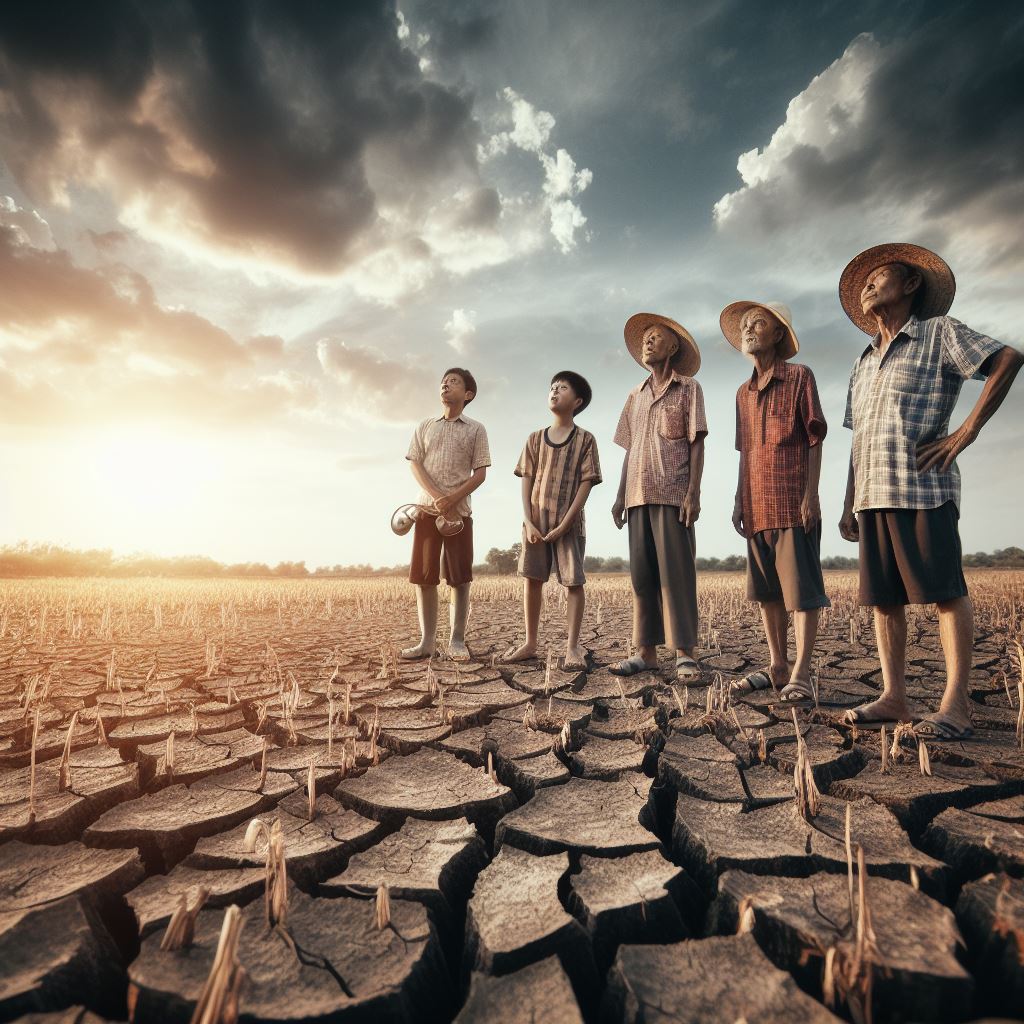Introduction
Water scarcity in farming is a pressing issue.
Crops wither, livelihoods suffer.
Efficient irrigation methods must replace outdated ones. Conservation practices demand adoption.
Government policies must prioritize sustainable water use. Farmers can embrace technology to monitor water usage.
Drip irrigation and rainwater harvesting hold promise.
Educating communities about water conservation becomes imperative. Collective efforts are paramount to combat this challenge.
Water is finite; our responsibility is infinite.
Every drop saved in farming is a step towards a greener future. The clock is ticking, and action is overdue.
Water scarcity in farming demands immediate attention, collaboration, and innovative solutions.
The soil thirsts, and so do the farmers. It’s time to quench the earth’s longing for sustenance.
Causes of Water Scarcity in Farming
Water scarcity in farming is a growing concern worldwide, affecting agricultural production and food security.
Several factors contribute to this issue:
Climate change and variations in rainfall patterns
With climate change, the Earth’s weather patterns are becoming increasingly unpredictable, leading to irregular rainfall distribution.
This affects farming as crops rely on sufficient and timely rainfall for growth and development.
Increased demand for water in agriculture
The growing global population and the shift towards an urbanized lifestyle have resulted in a higher demand for agricultural products.
Transform Your Agribusiness
Unlock your farm's potential with expert advice tailored to your needs. Get actionable steps that drive real results.
Get StartedAs a consequence, more water is needed for irrigation, livestock, and processing, straining water resources.
Inefficient irrigation methods
The outdated and inefficient irrigation techniques utilized in many farming systems contribute to water scarcity.
Flood irrigation, for instance, can result in excessive evaporation and runoff, leading to wastage of water.
Pollution and contamination of water sources
Water pollution from chemicals, pesticides, and fertilizers used in farming practices can contaminate water sources, making them unsuitable for farming.
This pollution reduces the available water for agricultural purposes.
Addressing these causes of water scarcity requires a multifaceted approach that involves sustainable farming practices and better water management.
Adopting drought-tolerant crops
Farmers can mitigate the impact of variations in rainfall patterns by choosing to cultivate drought-tolerant crop varieties.
These crops are genetically modified to withstand water scarcity and are more resilient to unfavorable climatic conditions.
Implementing efficient irrigation systems
The use of modern irrigation methods such as drip irrigation or precision sprinklers can minimize water wastage by delivering water directly to the plants’ root zone.
These systems reduce evaporation and runoff, increasing water use efficiency.
Enhancing water storage and conservation
Farmers can install systems for rainwater harvesting and storage, ensuring a steady supply of water during dry periods.
Strategies like contour plowing and mulching help retain moisture in the soil, reducing the need for excessive irrigation.
Promoting sustainable agricultural practices
Reducing the use of chemical inputs in farming can prevent water pollution and contamination.
Organic farming methods, crop rotation, and integrated pest management are sustainable alternatives that protect water quality and preserve natural resources.
Strengthening water governance and policies
Governments and institutions play a critical role in managing water resources.
Implementing regulations, providing incentives for efficient water use, and investing in infrastructure can help alleviate water scarcity challenges in farming.
In short water scarcity in farming is caused by climate change, increased water demand, inefficient irrigation, and water pollution.
Addressing these causes requires a holistic approach that combines technological advancements, sustainable practices, and effective water management policies.
By adopting these measures, it is possible to mitigate the impact of water scarcity and ensure a sustainable future for agriculture.
Read: Container Gardening: Ideal for Small Areas
Impact of Water Scarcity on Farming
The scarcity of water in farming has far-reaching consequences that affect various aspects of agricultural production and the global food system.
Reduced crop yields and quality
- Water scarcity leads to reduced crop yields as plants do not receive an adequate water supply.
- Insufficient water availability can also affect the quality of crops, resulting in lower nutritional value and market value.
- Drought conditions caused by water scarcity can lead to crop failure and loss of income for farmers.
- The lack of water hinders the optimal growth and development of plants, impacting their overall productivity.
Increased vulnerability to pests and diseases
- Water-stressed plants are more susceptible to pests and diseases, as their weakened state compromises their natural defense mechanisms.
- Inadequate water supply can weaken plants, making them more attractive to pests and reducing their ability to recover from diseases.
- Increased pest and disease pressure further decreases crop yields and can lead to significant economic losses for farmers.
Economic implications for farmers, especially small-scale ones
- Water scarcity poses economic challenges for farmers, forcing them to invest in expensive irrigation systems or rely on costly water sources.
- Small-scale farmers, with limited resources and access to water, are particularly affected by water scarcity, exacerbating existing inequalities in the agricultural sector.
- Expenses related to water scarcity, such as higher energy costs for pumping water, can reduce farmers’ profitability and financial stability.
- Declining crop yields and quality not only impact the income of farmers but also disrupt local and regional food supply chains.
Threats to food security and global food production
- Water scarcity jeopardizes food security by reducing the availability of staple crops and essential agricultural products.
- As population growth continues, the demand for food increases, and water scarcity puts pressure on meeting this demand, potentially leading to food shortages.
- Decreased agricultural productivity due to water scarcity can have long-term implications for global food production and trade, affecting food prices and availability worldwide.
In essence, water scarcity significantly impacts farming practices and the global food system.
Reduced crop yields, increased vulnerability to pests and diseases, economic challenges for farmers, and threats to food security and global food production highlight the urgent need for sustainable water management in agriculture.
Read: Gardening Tools: Must-Haves for Beginners
Showcase Your Farming Business
Publish your professional farming services profile on our blog for a one-time fee of $200 and reach a dedicated audience of farmers and agribusiness owners.
Publish Your Profile
Current Initiatives to Address Water Scarcity in Farming
Water conservation techniques and practices
- Implementing efficient irrigation systems like drip irrigation to reduce water wastage.
- Employing mulching and cover crops to decrease evaporation and maintain soil moisture.
- Practicing crop rotation and intercropping to optimize water usage and reduce water stress.
- Adopting soil management techniques such as contour plowing and terracing to capture rainwater effectively.
Adoption of precision irrigation systems
- Using sensor-based technologies to monitor soil moisture levels and deliver the precise amount of water needed.
- Embracing automated irrigation systems that adjust water application based on weather conditions and plant requirements.
- Incorporating variable rate irrigation to apply differing amounts of water across a field, based on soil moisture variability.
Water-saving technologies and innovations
- Implementing hydroponic and aeroponic systems that use significantly less water compared to traditional soil-based farming.
- Employing greenhouses and vertical farming techniques that allow better control over water usage through recirculation and optimization.
- Utilizing advanced water-saving agricultural practices like rainwater harvesting, fogging systems, and wastewater management.
Government policies and subsidies to promote water conservation in agriculture
- Providing financial incentives to farmers who adopt water-efficient practices and invest in innovative technologies.
- Regulating water use by issuing permits and licenses, ensuring sustainable utilization of water resources.
- Encouraging research and development programs focused on finding new ways to conserve water in farming.
- Collaborating with international organizations to exchange knowledge and expertise in water management strategies.
By implementing these initiatives, the agriculture industry can combat water scarcity challenges and ensure sustainable farming practices.
It is crucial for governments, farmers, and stakeholders to work together continuously and adapt to changing environmental conditions.
By adopting innovative techniques and policies, we can secure water resources for future generations and sustain food production globally.
Read: Sustainable Practices for Small Farms
Learn More: Rainwater Harvesting: Boost for Sustainable Farms
Case Studies: Successful Water Scarcity Mitigation Strategies in Farming
Drip irrigation systems in a drought-affected region
- Benefits and outcomes
- Lessons learned
Water recycling and reuse techniques in a water-stressed farming community
- Positive impact on water availability
- Challenges and potential for improvement
Water scarcity in farming is an increasingly concerning issue that requires effective mitigation strategies.
In this section, we will explore two case studies that highlight successful approaches in combating water scarcity in agricultural practices.
Case study 1: Drip irrigation systems in a drought-affected region
One of the most promising strategies for addressing water scarcity in farming is the adoption of drip irrigation systems.
This case study focuses on a drought-affected region where farmers implemented this technology.
Drip irrigation systems have numerous benefits and have shown significant positive outcomes.
Firstly, these systems require significantly less water compared to traditional irrigation methods.
By delivering water directly to the plants’ roots, drip irrigation minimizes evaporation and ensures optimal water usage.
Moreover, drip irrigation has been proven to increase crop yield and quality.
By providing a continuous and controlled water supply, farmers observed improved plant growth and higher agricultural productivity.
This resulted in increased profitability and economic stability for the farmers in the drought-affected region.
Implementing drip irrigation systems also uncovered several valuable lessons.
Farmers learned the importance of proper maintenance and regular checks to ensure the system’s efficiency.
Regular maintenance not only maximizes water conservation but also prevents potential system failures, which could result in crop losses.
Case study 2: Water recycling and reuse techniques in a water-stressed farming community
Another effective approach to mitigating water scarcity in farming is the adoption of water recycling and reuse techniques.
This case study highlights how these techniques positively impact water availability in a water-stressed farming community.
Water recycling and reuse techniques offer a sustainable solution by reducing the dependency on freshwater sources.
By treating and reusing wastewater, farmers can significantly reduce their reliance on traditional water supplies.
This not only conserves water resources but also alleviates the strain on existing water sources.
The positive impact of water recycling and reuse techniques on water availability is evident.
Farmers not only have a more reliable water supply for irrigation but also benefit from lower water bills.
By utilizing recycled water, farmers can maintain agricultural practices even during drought periods, ensuring food security for the community.
However, implementing water recycling and reuse techniques does come with challenges and the potential for improvement.
One of the major challenges is the initial investment required for setting up proper wastewater treatment infrastructure.
Additionally, ensuring the quality and safety of recycled water for agricultural purposes remains a priority.
Continuous research and innovation are necessary to enhance the efficiency and effectiveness of these techniques.
Basically, these case studies demonstrate successful water scarcity mitigation strategies in farming.
Drip irrigation systems and water recycling and reuse techniques offer viable solutions with numerous benefits, including increased water efficiency, improved crop yield, and reduced reliance on freshwater sources.
By learning from these case studies and implementing similar approaches, farmers can effectively address water scarcity concerns, ensuring sustainable agriculture for the future.
Read: Beekeeping: Boosting Your Garden’s Health
Gain More Insights: US Farm Policy vs. Climate Change: A Deep Dive
Future Outlook: Potential Solutions and Recommendations
- Investment in research and development of advanced irrigation technologies
- Improved water management practices and education for farmers
- Collaboration between government, farmers, and environmental organizations
- Policy changes and regulations to prioritize water conservation in agriculture
As water scarcity in farming continues to threaten global food security, it is crucial to explore potential solutions and recommendations.
The future outlook relies on a combination of investment in research and development, improved water management practices, collaboration, and policy changes.
Investment in research and development of advanced irrigation technologies
To address water scarcity in farming, investment in research and development of advanced irrigation technologies is essential.
This includes exploring innovative irrigation methods such as precision irrigation, micro-irrigation, and the use of smart sensors.
These technologies can optimize water use by delivering water directly to plant roots while minimizing evaporation and runoff.
Showcase Your Farming Business
Publish your professional farming services profile on our blog for a one-time fee of $200 and reach a dedicated audience of farmers and agribusiness owners.
Publish Your ProfileBy investing in these advancements, farmers can maximize their crop yield while minimizing water usage.
Improved water management practices and education for farmers
Another crucial aspect of tackling water scarcity in farming is the adoption of improved water management practices.
Farmers need access to education and training programs that emphasize efficient water use, proper irrigation techniques, and soil moisture monitoring.
By implementing these practices, farmers can minimize water waste and ensure that irrigation is aligned with crop water requirements.
Incorporating crop rotation and implementing water-efficient irrigation scheduling can further optimize water use.
Collaboration between government, farmers, and environmental organizations
Addressing water scarcity in farming requires collaboration between various stakeholders.
Government agencies, farmers, and environmental organizations must work hand in hand to develop and implement sustainable water management strategies.
This includes sharing knowledge, resources, and best practices.
Collaborative efforts can lead to the establishment of water-sharing agreements, the construction of water storage infrastructure, and the development of drought-resistant crop varieties.
By working together, stakeholders can create holistic solutions that benefit both farmers and the environment.
Policy changes and regulations to prioritize water conservation in agriculture
Policy changes and regulations play a crucial role in prioritizing water conservation in agriculture.
Governments need to develop and enforce policies that promote sustainable water use practices.
This includes implementing water pricing mechanisms that incentivize efficient water management and provide financial support for the adoption of advanced irrigation technologies.
Additionally, regulations should be in place to control water extraction, prevent water pollution from agricultural activities, and promote the reuse of treated wastewater for irrigation purposes.
Tackling water scarcity in farming requires a multi-faceted approach.
Investments in research and development, improved water management practices, collaborations, and policy changes are necessary to ensure a sustainable future for agriculture.
By implementing these potential solutions and recommendations, we can mitigate the effects of water scarcity in farming and secure global food production.
Conclusion
Water scarcity in farming is a pressing issue that needs immediate attention.
With the growing global population, the demand for food will only increase, putting additional pressure on water resources.
We must address this concern to ensure sustainable farming and food security for future generations.
It is crucial to recognize the importance of water conservation in farming.
Without adequate water supply, crops will wither, leading to lower agricultural yields and potential food shortages.
As a result, it is vital to prioritize and invest in sustainable water management practices.
Individuals, farmers, and policymakers all play a crucial role in addressing water scarcity in farming.
Individuals can contribute by being mindful of their water usage at home and supporting sustainable farming practices.
Farmers can adopt efficient irrigation methods and implement water-saving technologies.
Policymakers should establish and enforce regulations that promote responsible water use and incentivize farmers to prioritize water conservation.
By collaborating and prioritizing water conservation efforts, we can mitigate the impacts of water scarcity in farming.
Together, we can ensure a sustainable future for agriculture and guarantee food security for all.




